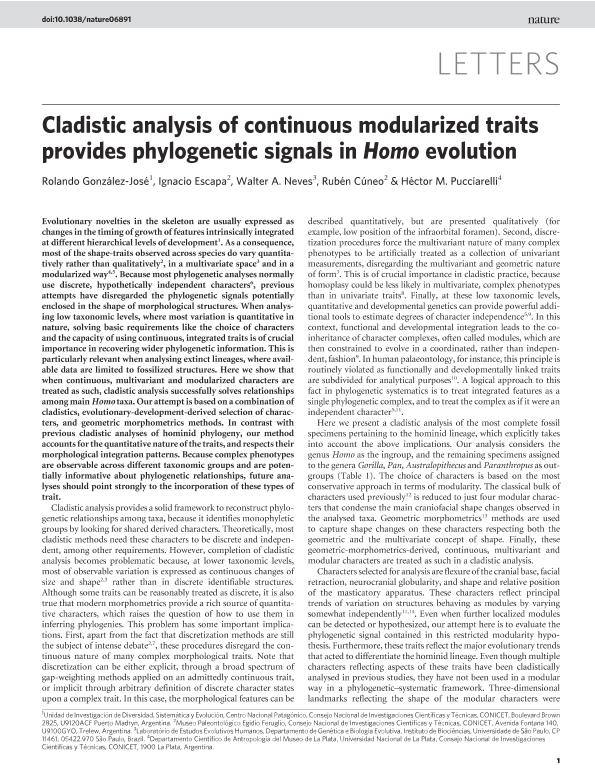Mostrar el registro sencillo del ítem
dc.contributor.author
González José, Rolando

dc.contributor.author
Escapa, Ignacio Hernán

dc.contributor.author
Neves, Walter A.
dc.contributor.author
Cúneo, Néstor Rubén

dc.contributor.author
Pucciarelli, Hector Mario

dc.date.available
2020-01-30T18:23:33Z
dc.date.issued
2008-06
dc.identifier.citation
González José, Rolando; Escapa, Ignacio Hernán; Neves, Walter A.; Cúneo, Néstor Rubén; Pucciarelli, Hector Mario; Cladistic analysis of continuous modularized traits provides phylogenetic signals in Homo evolution; Nature Publishing Group; Nature; 453; 7196; 6-2008; 775-778
dc.identifier.issn
0028-0836
dc.identifier.uri
http://hdl.handle.net/11336/96243
dc.description.abstract
Evolutionary novelties in the skeleton are usually expressed as changes in the timing of growth of features intrinsically integrated at different hierarchical levels of development. As a consequence, most of the shape-traits observed across species do vary quantitatively rather than qualitatively, in a multivariate space and in a modularized way. Because most phylogenetic analyses normally use discrete, hypothetically independent characters, previous attempts have disregarded the phylogenetic signals potentially enclosed in the shape of morphological structures. When analysing low taxonomic levels, where most variation is quantitative in nature, solving basic requirements like the choice of characters and the capacity of using continuous, integrated traits is of crucial importance in recovering wider phylogenetic information. This is particularly relevant when analysing extinct lineages, where available data are limited to fossilized structures. Here we show that when continuous, multivariant and modularized characters are treated as such, cladistic analysis successfully solves relationships among main Homo taxa. Our attempt is based on a combination of cladistics, evolutionary-development-derived selection of characters, and geometric morphometrics methods. In contrast with previous cladistic analyses of hominid phylogeny, our method accounts for the quantitative nature of the traits, and respects their morphological integration patterns. Because complex phenotypes are observable across different taxonomic groups and are potentially informative about phylogenetic relationships, future analyses should point strongly to the incorporation of these types of trait.
dc.format
application/pdf
dc.language.iso
eng
dc.publisher
Nature Publishing Group

dc.rights
info:eu-repo/semantics/openAccess
dc.rights.uri
https://creativecommons.org/licenses/by-nc-sa/2.5/ar/
dc.subject
N/A
dc.subject.classification
Geología

dc.subject.classification
Ciencias de la Tierra y relacionadas con el Medio Ambiente

dc.subject.classification
CIENCIAS NATURALES Y EXACTAS

dc.title
Cladistic analysis of continuous modularized traits provides phylogenetic signals in Homo evolution
dc.type
info:eu-repo/semantics/article
dc.type
info:ar-repo/semantics/artículo
dc.type
info:eu-repo/semantics/publishedVersion
dc.date.updated
2020-01-29T15:42:15Z
dc.journal.volume
453
dc.journal.number
7196
dc.journal.pagination
775-778
dc.journal.pais
Reino Unido

dc.journal.ciudad
Londres
dc.description.fil
Fil: González José, Rolando. Consejo Nacional de Investigaciones Científicas y Técnicas. Centro Científico Tecnológico Conicet - Centro Nacional Patagónico; Argentina
dc.description.fil
Fil: Escapa, Ignacio Hernán. Consejo Nacional de Investigaciones Científicas y Técnicas; Argentina. Museo Paleontologico Egidio Feruglio; Argentina
dc.description.fil
Fil: Neves, Walter A.. Universidade de Sao Paulo; Brasil
dc.description.fil
Fil: Cúneo, Néstor Rubén. Museo Paleontologico Egidio Feruglio; Argentina. Consejo Nacional de Investigaciones Científicas y Técnicas; Argentina
dc.description.fil
Fil: Pucciarelli, Hector Mario. Universidad Nacional de La Plata; Argentina. Consejo Nacional de Investigaciones Científicas y Técnicas; Argentina
dc.journal.title
Nature

dc.relation.alternativeid
info:eu-repo/semantics/altIdentifier/url/https://www.nature.com/articles/nature06891
dc.relation.alternativeid
info:eu-repo/semantics/altIdentifier/doi/https://doi.org/10.1038/nature06891
Archivos asociados
